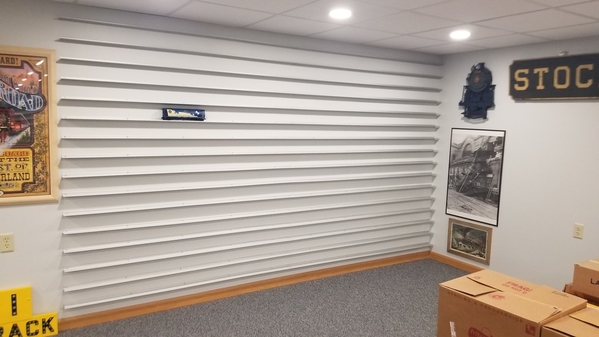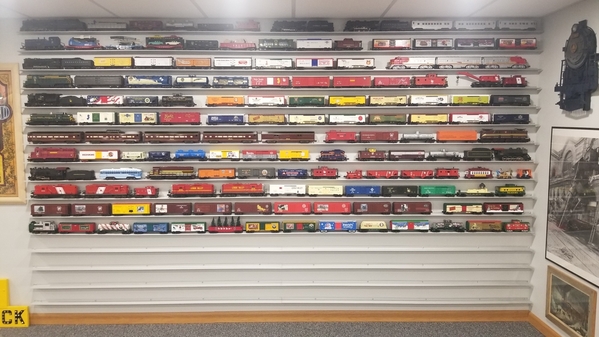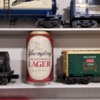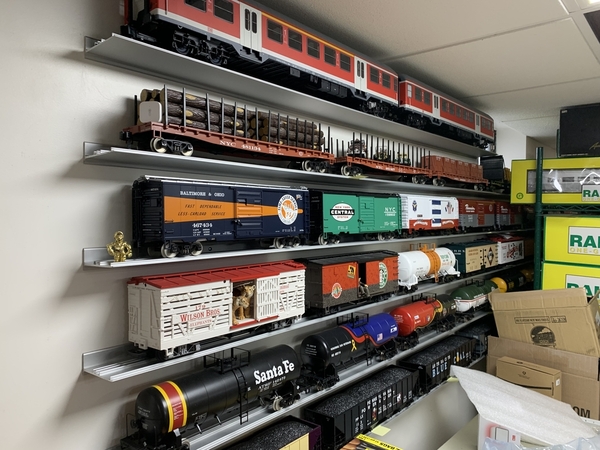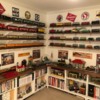How wide should shelves be, and how much space, needed between them? (ie; 5" wide, 10" between ) ? Thanks.
Replies sorted oldest to newest
I
@NJCJOE posted:
What a great idea! I'm gonna get right to buildin', only I'm gonna use a different can for each one.
Measure the height of the box of the tallest car and use that as your reference. You need enough room for the car + hand + clearance to lift things on and off the shelf.
I have plaster walls so the aluminum shelving does not work for me. I use the tried and true vertical slotted pieces mounted to vertical 1x4s and brackets, normally 6". I use 1x4 lumber for the shelves with two grooves cut for the trucks. Spacing between the shelves is 5 1/4". Some items are taller but you can put them on a different spacing. I used to sit the trains on Gargraves track but after about 1000' it was starting to get expensive.
Attachments
Thanks to all.
O-scale models, 5 inch spacing, minimum. IMO. One, 2 1/2" #10 pan head screw, installed, center of each wall studs. Aluminum shelf suppliers would have an installation page on their web page.
Width: For O-gauge items, I use a nominal 1x4. For Standard Gauge, I use a nominal 1x6. Beware of sag - I now make mine with a 1/4" plywood backer.
Height: Varies, depending on equipment. Pantographs and other protrusions (giraffe heads, etc.) create challenges. In hindsight, I would have space for more items if I had designated each shelf for specific types of equipment and scaled the height accordingly - i.e., gondola cars require less height than boxcars, scale boxcars are taller than 6464 boxcars, etc.
I use short lengths of 2x4 as spacers when setting the shelves - just be sure that the first reference shelf is level. ![]()
i love the beer/clam chowder standard that's been applied here ![]()
![]()
@NJCJOE posted:
Why did you switch over to the aluminum shelves? You outgrew them?
I was planning to get some aluminum shelving, but your old wood setup is so beautiful!
Thanks,
Jim
My original wood shelves were 4 inches wide with 5 1/2 separation. However in this house my wall space is more limited so the newer shelves are built with 5 1/2 wide and 6 inch separation to accommodate double stack container cars. The reason for the extra width is so I can put two cars deep on the easy to reach shelves. The thinking is how many coal cars of a unit train do I really need to display, same with tankers, shipping, etc,...
Mike in NC,
@CNJ Jim posted:Why did you switch over to the aluminum shelves? You outgrew them?
I was planning to get some aluminum shelving, but your old wood setup is so beautiful!
Thanks,
Jim
When we moved, the new basement had a more modern look and I felt the aluminum shelves would look better than the wood shelves I previously had.
Good info all. I 'love' the beer can trick. Maybe use a large 'Bake beans' can?
I used 1 X 6 pine, 6 foot lengths, stained and mounted with readily available standards and brackets. The spacing works out to just a tick over 7” between the selves, more than enough room for O gauge trains, but just fine for when I display my Standard or 1 Gauge items.
Attachments
Pre war Steve, I like that layout.
@yardtrain posted:
Plaster walls are board and batten construction. That’s nothing like drywall and studs, which support shelves more readily without damage and the potential for collapse.
I used 1x4 furring strips cut into 7 foot lengths with 1x3 furring strips screwed into back of the 1x4 boards to hold everything together. The 1x3 were placed where the vertical wood studs were located to drive screws into the wall.
I made 2 - 10 shelf units each with 6 screws into the wall studs. I stained the bare wood before they were attached to the walls.
So. this was done inside my house being floor to ceiling display with a similar one on the entire back wall of the garage.
Attachments
@yardtrain posted:But there must be studs behind all that ?
I think I should have used the term "lath and plaster" walls. The problem is you can't find the studs with a stud sensor. The lath strips are too dense to allow it. You can use anchors into the laths, but the laths aren't intended to hold a lot of weight. If you a lath strip breaks, the plaster wall can be badly damaged.
The safer bet is to install shelving units instead of using the wall itself as the backing for the shelves.
Finding wall studs.
(1.) Both hands on the wall, knock or tap, one hand, check for movement/vibration the other hand. Stud location is firm. Even ancient wood lath will flex/vibrate.
(2.) Studs, usually are 16" of 24" on center, find one, you should be able to determine the wall framing.
(3.) Once you have located a stud, (1 1/2" to 2") width, determine the center of the stud, best location for an attachment.
(4.) Screws. Pan head, ( or hex head), tapping, 2 1/2" long.
(5.) Very old house, balloon framing, the studs may be visible in the basement/or attic.
(6.) Door, window framing alters the stud layout.
(7.) Have fun. Patching holes, part of any remodel project.
@Jim R. posted:I think I should have used the term "lath and plaster" walls. The problem is you can't find the studs with a stud sensor. The lath strips are too dense to allow it. You can use anchors into the laths, but the laths aren't intended to hold a lot of weight. If you a lath strip breaks, the plaster wall can be badly damaged.
The safer bet is to install shelving units instead of using the wall itself as the backing for the shelves.
There are electronic stud sensors which claim to work "deep". I don't have lath & plaster walls, so can't speak to their effectiveness. Would be very useful if they work reliably.
@Ted Bertiger posted:I used 1x4 furring strips cut into 7 foot lengths with 1x3 furring strips screwed into back of the 1x4 boards to hold everything together. The 1x3 were placed where the vertical wood studs were located to drive screws into the wall.
I made 2 - 10 shelf units each with 6 screws into the wall studs. I stained the bare wood before they were attached to the walls.
So. this was done inside my house being floor to ceiling display with a similar one on the entire back wall of the garage.
Furring strips are a good idea. And I like the top shelf for box storage - I wish I had the headroom above my shelves to do that.
I've lived in houses with plaster and lath walls. There are two basic types -- those with metal screen over the wooden lath strips (relatively newer homes, to help with plaster adhesion) and those without (much older homes). The screen tends to mess with stud finders, but the plaster layer is usually thinner. The plaster is usually thicker on the kinds without screen -- it's typically the old "horsehair plaster" or some other type that has long fibers mixed into the plaster.
With either type, there are screw anchors which have enough of a toggle or some other kind of backing piece which will work in plaster walls, as long as you keep them spaced closely enough that you're not putting a load across a wide span of plaster wall with a shelf. In some cases, the thick metal "masonry" anchors are a good choice. (I've used those successfully to hang speakers on angle mounts that extend them out from the wall, which puts a lot of weight and leverage plus vibration on the anchor point.) You typically need to up-size the anchors with plaster walls. Which means larger holes, more mess, and possibly more fasteners anyway which just adds up cost. Plaster is no fun to deal with, but hanging solutions are possible as long as you can avoid overloading the fastening points. I've seen large, heavy mirrors hung on plaster walls with nailed-in hooks. That were hanging there for decades. I wouldn't trust that to hold, but people did it back in the day...
If I were doing train shelves, though, that's going to be a lot of fasteners close together and a lot of overall weight. I'd consider mounting good, clear, sanded plywood panels to the wall and then trimming out and painting them to look like they belong there and then attach the shelves to the plywood.
Mine are 4” baseboard attached to a 1x2 and anchored into the studs. I purchased some cheap used ME track to place on them. They are painted my sky color to sort of float above my layout.
Attachments
Plaster Walls: My building was built in 1947. The construction is concrete, floor, structural supports and roof. The outside walls are hollow tile two layers thick with air gap in middle more are less about 12" - 14" thick. The interior walls are plaster. There are no 2x4's. There is vertical heavy rebar, metal lathe and plaster, about 3" thick.
That provides the difficulty in mounting any type of shelving. Aluminum will not work, there is no good way to secure it. I mount a vertical 1x4" sitting on the floor to the height I want the shelves and anchor it to the wall. The vertical slotted piece is then screwed to it and the brackets and 1x4 shelving mounted to it. Sometimes there is $20,000 worth of trains sitting on those shelves depending on the number of engines. I try and be careful.
Attachments
@Ted Bertiger posted:I used 1x4 furring strips cut into 7 foot lengths with 1x3 furring strips screwed into back of the 1x4 boards to hold everything together. The 1x3 were placed where the vertical wood studs were located to drive screws into the wall.
I made 2 - 10 shelf units each with 6 screws into the wall studs. I stained the bare wood before they were attached to the walls.
So. this was done inside my house being floor to ceiling display with a similar one on the entire back wall of the garage.
Furring strips are a good idea. And I like the top shelf for box storage - I wish I had the headroom above my shelves to do that.
Mallard4468, the top shelf for the empty boxes was made by the last owner whose brother was a carpenter. She had pegboard on the back garage wall so I was able to use his 1x1 vertical wood there to attached my 1x3 vertical strips there to hang the horizontal shelves. My garage has a 9 foot ceiling. On the very right is an example of the wood frame box shelving that he made and that goes around the left and right garage walls. Plenty of storage for my excess train equipment until I can build a home layout!!
I used a CD case as the spacer.
They are uniform in size, square and easy to find if you need to add more. Thick fancy molding makes it a little more fancy. Screwed to the beadboard backer so it can be moved around. Fits most freight car boxes and leaves room to grip. Being thinner on the outside edge give a little more room. Plus, the molding has a groove on the backside which helps catch the flange to keep them straight.
I made the error of putting them on the wall without a backer. I will never do that again.

Attachments
Don't have any pics but mine are 3.5" wide and 7" spacing. Used to place old track on top of the pine boards but now I just rip grooves at the width of O scale wheels.




